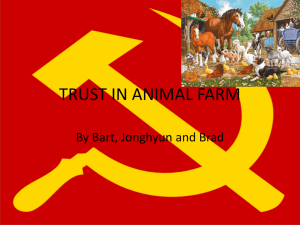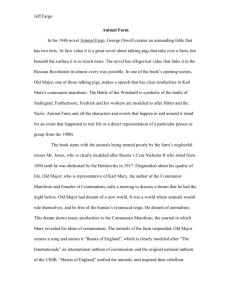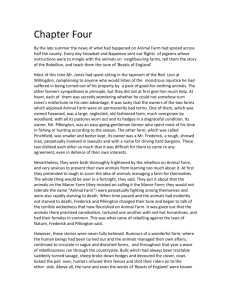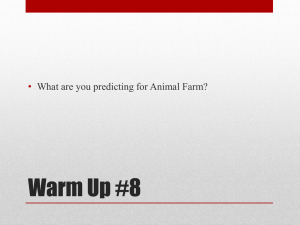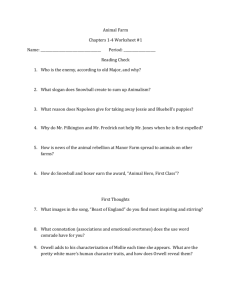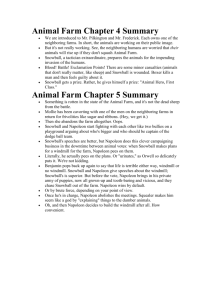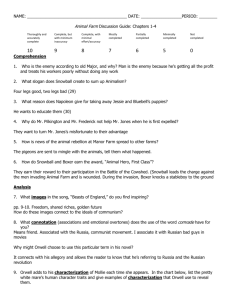Animal Farm Chapter 4
advertisement
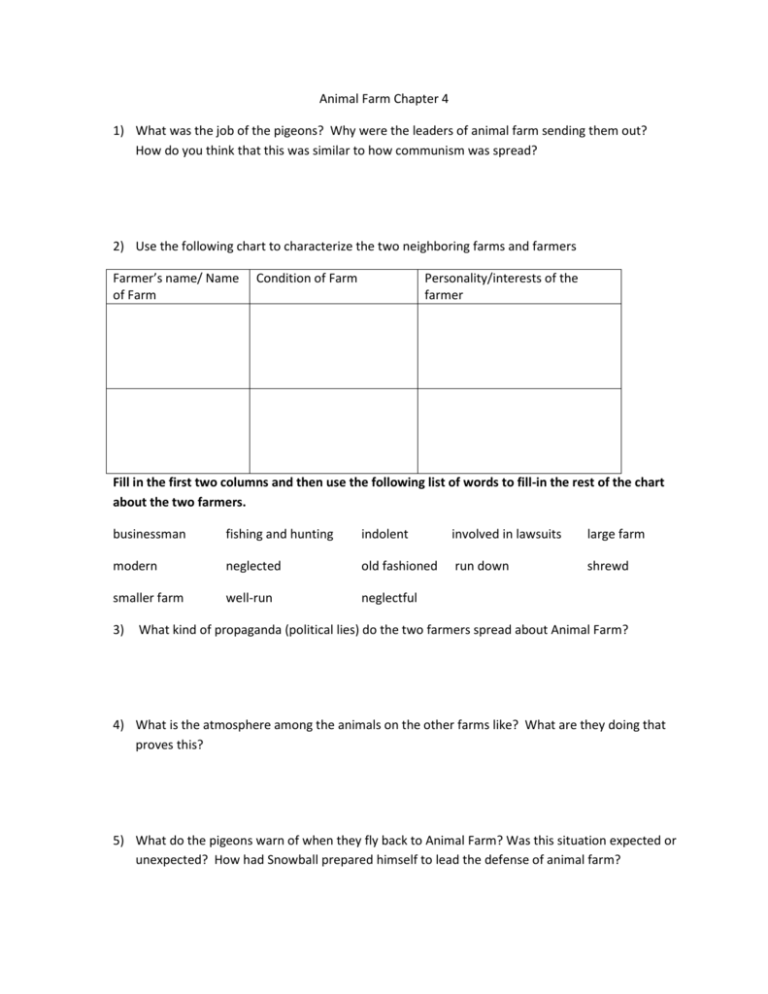
Animal Farm Chapter 4 1) What was the job of the pigeons? Why were the leaders of animal farm sending them out? How do you think that this was similar to how communism was spread? 2) Use the following chart to characterize the two neighboring farms and farmers Farmer’s name/ Name of Farm Condition of Farm Personality/interests of the farmer Fill in the first two columns and then use the following list of words to fill-in the rest of the chart about the two farmers. businessman fishing and hunting indolent involved in lawsuits large farm modern neglected old fashioned run down shrewd smaller farm well-run neglectful 3) What kind of propaganda (political lies) do the two farmers spread about Animal Farm? 4) What is the atmosphere among the animals on the other farms like? What are they doing that proves this? 5) What do the pigeons warn of when they fly back to Animal Farm? Was this situation expected or unexpected? How had Snowball prepared himself to lead the defense of animal farm? 6) Use this chart to describe the three phases of the maneuvers by the animals in, “The Battle of Cowshed.” The Battle of Cowshed The First Explain the battle strategy Wave Second Wave (The Diversion) Retreat Third Wave (The Ambush) 7) Who are the two best fighters among the animals? What does this tell you about them? 8) What two important characters were missing from the battle? Why? What does this tell you about each of them? 9) What were the battle medals called? Who got them? Why? Was this fair? Explain. 10) What was the battle named? Why? What was left behind? How did they use this? 11) Why is Boxer depressed at the end of the battle? What is Snowball’s reaction? Who do you agree with? Explain. Animal Farm Chapter 4 1) What was the job of the pigeons? Why were they doing this? Snowball and Napoleon sent out flights of pigeons whose instructions were to mingle with the animals on neighboring farms, tell them the story of the Rebellion, and teach them the tune of 'Beasts of England'. A) To spread the News of the Revolution/propaganda so other farms will rise up. B) Spies to find out what is happening on the other farms for defensive purposes. The tell of the upcoming attack 2) Use the following chart to characterize the two neighboring farms and farmers Farmer’s name Fredrick Name of Farm Pinchfield Condition of Farm Personality/interests Smaller farm Shrewd Well-Run Businessman Modern Involved in lawsuits Foxwood Large Farm Indolent Pilkington Neglected Hunting and fishing Rundown Neglectful Old fashioned Fill in the first two columns and the use the following list of words to fill-in the rest of the chart about the two farmers. businessman fishing and hunting indolent involved in lawsuits large farm modern neglected old fashioned run down shrewd smaller farm well-run 3) neglectful What kind of propaganda (political lies) do the two farmers spread about Animal Farm? Life was generally miserable. Animals were perpetually fighting among themselves and were also rapidly starving to death. When time passed and the animals had evidently not starved to death, Frederick and Pilkington changed their tune and began to talk of the terrible wickedness that now flourished on Animal Farm. It was given out that the animals there practiced cannibalism, tortured one another with red-hot horseshoes, and had their females in common. This was what came of rebelling against the laws of Nature, Frederick and Pilkington said. 4) What is the atmosphere among the animals on the other farms like? What are they doing that proves this? They are Restive-restless and impatient. A wave of rebelliousness ran through the countryside. Bulls which had always been tractable (obedient) suddenly turned savage, sheep broke down hedges and devoured the clover, cows kicked the pail over, horses refused (to jump over) their fences and shot their riders on to the other side. Above all, the tune and even the words of Beasts of England were known everywhere. It had spread with astonishing speed. 5) Why do the pigeons fly back to Animal Farm with a warning? Was this invasion expected or unexpected? How has Snowball prepared himself to lead the defense of animal farm? The pigeons return to warn of an impending attack from the humans/farmers. The attack was expected because of the pigeons’ warnings. Snowball had been studying the battle tactics of Julies Caesar, the great Roman general and emperor (Because Snowball had studied Julius Caesar’s military strategies, he was able to plan a successful defense of the farm. He led the animals in the attack and was wounded slightly.) 6) Use this chart to describe the three phases of the maneuvers by the animals in, “The Battle of Cowshed. The Battle of Cowshed The First Wave Explain the battle strategy 1st wave: All the pigeons, to the number of thirty-five, flew to and fro over the men's heads and muted upon them from mid-air; and while the men were dealing with this, the geese, who had been hiding behind the hedge, rushed out and pecked viciously at the calves of their legs. However, this was only a light skirmishing man oeuvre, intended to create a little disorder, and the men easily drove the geese off with their sticks. Second Wave (The Diversion) Retreat Snowball now launched his second line of attack. Muriel, Benjamin, and all the sheep, with Snowball at the head of them, rushed forward and prodded and butted the men from every side, while Benjamin turned around and lashed at them with his small hoofs. But once again the men, with their sticks and their hobnailed boots, were too strong for them; and suddenly, at a squeal from Snowball, which was the signal for retreat, all the animals turned and fled through the gateway into the yard Third Wave The men chased the animals as they retreated, through the gateway into the yard. (The Ambush) The men rushed after them in disorder. This was just what Snowball had intended. As soon as they were well inside the yard, the three horses, the three cows, and the rest of the pigs, who had been lying in ambush in the cowshed, suddenly emerged in their rear, cutting them off. Snowball now gave the signal for the charge. Snowball attacked Jones and Boxer and the cows used their hooves to beat off the men who made an ignominious (humiliating) retreat. 7) Who are the two best fighters among the animals? What does this tell you about them? Boxer and Snowball are the two best fighters. They are brave, loyal, and patriotic and true to the tenets of Animalism. Mollie on the other hand is cowardly and lazy and only wants the good life. She wants to be petted and wear ribbons and look at herself in the mirror. 8) What two important characters were missing from the battle? Why? What does this tell you about each of them? Mollie and Napoleon are missing. Molly was found hiding in her stall with her head buried among the hay in the manger. She had taken to flight as soon as the gun went off. She was probably afraid to break a nail/hoof. Nobody knows where Napoleon was. He was probably hiding. 9) What were the battle medals called? Who got them? Why? Was this fair? Explain. Animal Hero first class and Animal Hero second class. Boxer and Snowball got the Animal Hero first class and the dead sheep got the Animal Hero Second Class 10) What was the battle named? Why? What was left behind? How did they use this? The battle was called the Battle of Cowshed because that is where the battle was planned. (The gun symbolizes the successful fight against the humans. It will be fired ceremonially twice a year to celebrate the Battle of the Cowshed and on Midsummer’s Day, The anniversary of the Rebellion.) 11) Why is Boxer depressed at the end of the battle? What is Snowball’s reaction? Who do you agree with? Explain. He thinks that he has killed another creature and is sad because of that. Snowball thinks that in war casualties are a necessary evil. It shows that Boxer is very courageous and loyal to the cause, but he is also very caring. The 7 Commandments 1.Whatever goes upon two legs is an enemy. 2. Whatever goes upon four legs, or has wings, is a friend. 3. No animal shall wear clothes. 4. No animal shall sleep in a bed. (with sheets) 5. No animal shall drink alcohol. 6. No animal shall kill any other animal. 7. All animals are equal.

